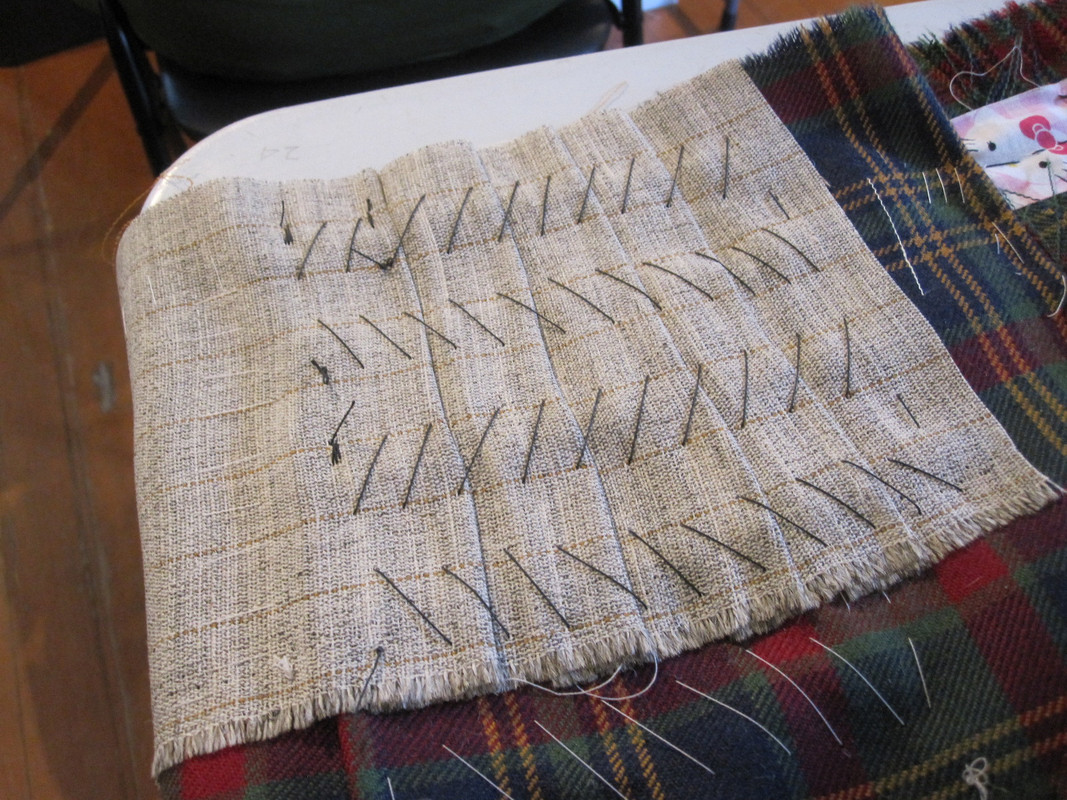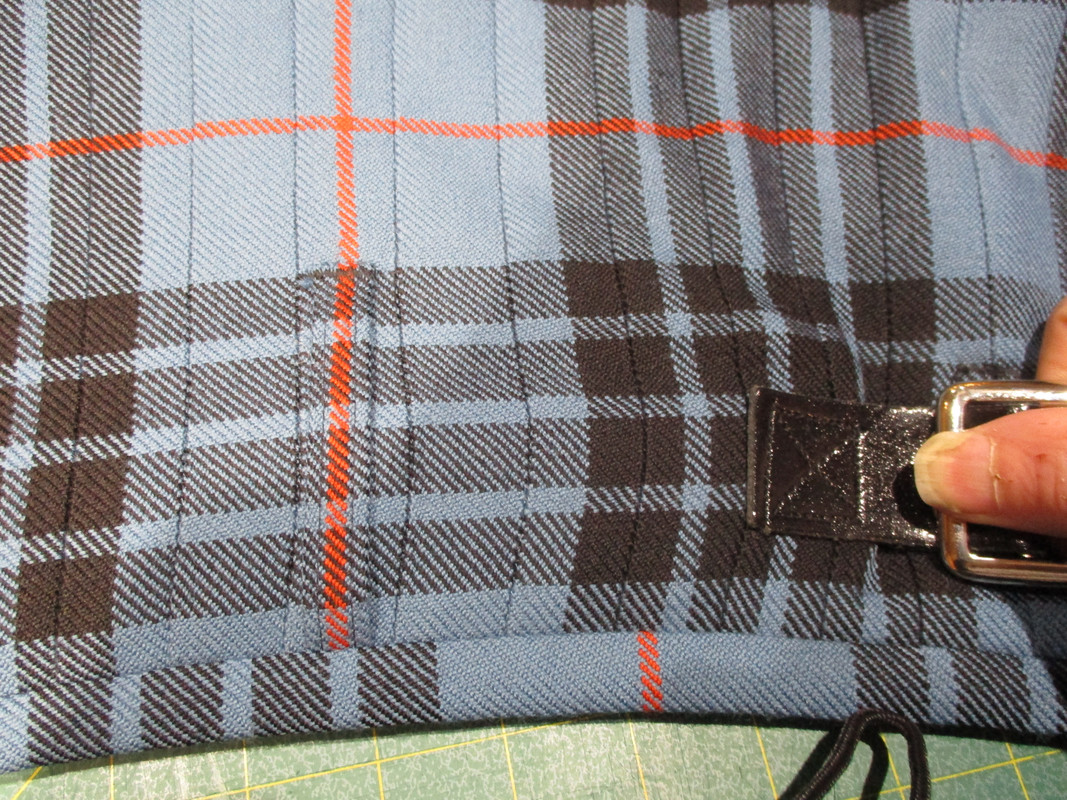|
-
15th June 25, 11:01 AM
#1
I yield to Pleaterís superior technical knowledge and general know how, on this matter.
" Rules are for the guidance of wise men and the adherence of idle minds and minor tyrants". Field Marshal Lord Slim.
-
The Following User Says 'Aye' to Jock Scot For This Useful Post:
-
15th June 25, 01:29 PM
#2
 Originally Posted by Jock Scot

I yield to Pleaterís superior technical knowledge and general know how, on this matter.
I don't have a middle name, but if I did it would be Pernickety.
Anne the Pleater
I presume to dictate to no man what he shall eat or drink or wherewithal he shall be clothed."
-- The Hon. Stuart Ruaidri Erskine, The Kilt & How to Wear It, 1901.
-
The Following 3 Users say 'Aye' to Pleater For This Useful Post:
-
15th June 25, 02:43 PM
#3
It is very possible that what has happened here is the Steeking line may have been sewn just a tad too tight.
To understand what I am referring to, you have to understand how a kilt made in the Traditional manner is constructed.
After the Fell Area (the area where the pleats are tapered and sewn down) is sewn, the excess material inside the kilt, that would be bulky due to the taper, is cut-away.

In effect, this weakens the garment, and the only thing holding the whole thing together, are the relatively weak hand stitches in the Fell Area.
And because some of the fabric is cut away the pleats will have a tendency to sag due to their own weight which is no longer supported.
So, a line of stitching is added. This is called "The Steeking Line". It is a line of stitching that hold and anchor each pleat - to the pleats under it, but to not go all the way through to the outside of the kilt.
If the stitches of the Steeking line are pulled too tight as they are sewn they can "Telegraph" to the outside and will appear just as what is seen in your kilt.

The problem for you is that the Steeking Line cannot be seen from the outside and is covered by the interfacing and liner on the inside.
The liner of a kilt made in the Traditional manner is not a structural component. It's only purpose is to cover up what is underneath.
Because the excess fabric is cut-away in the Fell Area you must add a structural element called the "Stabilizer". This is a piece of fabric that is very strong and will resist stretching in the lengthwise direction. It is added inside and goes from one buckle, across the back, to the other buckle.
You can think of the Stabilizer as an internal belt. It is the primary horizontal strengthening element of the Garment.

(On this kilt the 'flame' patterned fabric is just for fun. No one will ever see it after the kilt is finished.)
After the Steeking and the Stabilizer are in, the Horizontal Stiffening Element is added. This is called "The Interfacing". It is usually made from a fabric called "Hair Canvas" or "Suit Coat Chest Canvas". It is stiffer in the vertical direction than in the horizontal direction.

Now a light Liner is sewn in to cover and hide all this internal construction and its elements.

After all of this hidden work, the Fell Area of a Traditionally made kilt, can stand up all on its own.

Now - on your kilt, if the Fell Area cannot stand up on its own - or if you can lift the liner and there is little to nothing under it - Then your kilt is not made in the Traditional manner and everything I have just posted is for naught.

If you can pull on the buckles and you see the pleats in the Fell Area stretch, then your kilt is not made in the Traditional manner -

and everything I have just posted is for naught.
But it is possible that what you are seeing in your kilt is due to tight Steeking Stitches and that will not be fixed by steaming. More than likely the kilt will need to be partial de-constructed to gain access to the Steeking line.
Last edited by Steve Ashton; 15th June 25 at 02:47 PM.
-
The Following User Says 'Aye' to Steve Ashton For This Useful Post:
-
16th June 25, 03:13 PM
#4
 Originally Posted by Steve Ashton

It is very possible that what has happened here is the Steeking line may have been sewn just a tad too tight.
If you can pull on the buckles and you see the pleats in the Fell Area stretch, then your kilt is not made in the Traditional manner -

and everything I have just posted is for naught.
But it is possible that what you are seeing in your kilt is due to tight Steeking Stitches and that will not be fixed by steaming. More than likely the kilt will need to be partial de-constructed to gain access to the Steeking line.
Thank you very much for a thorough reply. I will check both the standing-up technique and the pulling test tomorrow.
QUOTE=CBH;1411743]OP -
Good luck with your decision.[/QUOTE]
Thank you!
QUOTE=Jock Scot;1411745]Also , if the ďfaultĒ niggles you that much, then the kilt needs to be returned to its maker forthwith.[/QUOTE]
I'm afraid it does. I don't want it too, but I never stop seeing those things.
K
-
-
17th June 25, 01:31 PM
#5
 Originally Posted by Steve Ashton

It is very possible that what has happened here is the Steeking line may have been sewn just a tad too tight.
After all of this hidden work, the Fell Area of a Traditionally made kilt, can stand up all on its own.
Now - on your kilt, if the Fell Area cannot stand up on its own - or if you can lift the liner and there is little to nothing under it - Then your kilt is not made in the Traditional manner and everything I have just posted is for naught.
If you can pull on the buckles and you see the pleats in the Fell Area stretch, then your kilt is not made in the Traditional manner -
and everything I have just posted is for naught.
But it is possible that what you are seeing in your kilt is due to tight Steeking Stitches and that will not be fixed by steaming. More than likely the kilt will need to be partial de-constructed to gain access to the Steeking line.
Good Evening Steve!
Iíve done the test.
When I pull the buckles it stretches, but only a little bit. So little that we are talking a total of 0,5cm ish in total from one buckle to the other. So Iím pretty sure there its done proper.
Also, the kilt does stand up on its own, although not as easy as it appears on the image you attached. But I assume this has something to do with the fabric as well. If its a light, medium or a heavy kilt. I think they mentioned this being a 13 oz, but i might be wrong.
So as far as I can tell, IF there is a fault in my kilt. Then Iím leaning towards yours or Annes theory.
1. Placed on a support slightly off true before sewing together and now the inner part of the pleats are being drawn to the left
2. The Steeking line have been sewn just a tad too tight.
Perhaps it's best to send it back so they can take a look. Iíll send them a new email summarizing the thoughts from this thread and ask for their opinion.
Thank you so much for all your help so faróIíll keep you posted!
K
-
-
15th June 25, 03:47 PM
#6
 Originally Posted by Pleater

I don't have a middle name, but if I did it would be Pernickety.
Anne the Pleater
I thought from your posts that your middle name was "the" as above.
Rev'd Father Bill White: Mostly retired Parish Priest & former Elementary Headmaster. Lover of God, dogs, most people, joy, tradition, humour & clarity. Legion Padre, theologian, teacher, philosopher, linguist, encourager of hearts & souls & a firm believer in dignity, decency, & duty. A proud Canadian Sinclair with solid Welsh and other heritage.
-
The Following User Says 'Aye' to Father Bill For This Useful Post:
-
15th June 25, 05:45 PM
#7
OP - this is a lot to take in. Sorry for your plight !!
In all honesty though, I still struggled to see much wrong with it.
I'm sure it will not be easy nor cheap to get the kilt back to the maker, get them to re-work it - and hopefully fix it and not make something else worse - all in time for the wedding.
Good luck with your decision.
-
-
15th June 25, 08:14 PM
#8
Well alright, perhaps if the kilt construction is going to cause the kilt to fail in the next few years, then perhaps something needs to be done to correct that fault. Otherwise, just carry on wearing it. Also , if the “fault” niggles you that much, then the kilt needs to be returned to its maker forthwith.
Last edited by Jock Scot; 15th June 25 at 08:17 PM.
" Rules are for the guidance of wise men and the adherence of idle minds and minor tyrants". Field Marshal Lord Slim.
-
-
17th June 25, 10:16 AM
#9
 Originally Posted by Father Bill

I thought from your posts that your middle name was "the" as above.
Ah that is just the honorific given to survivors - you might look up Terry Pratchett's Cohen the Barbarian for comparison if you are not already familiar with him. Just don't look at him funny - Cohen that is.
Anne the Pleater
I presume to dictate to no man what he shall eat or drink or wherewithal he shall be clothed."
-- The Hon. Stuart Ruaidri Erskine, The Kilt & How to Wear It, 1901.
-
The Following User Says 'Aye' to Pleater For This Useful Post:
 Posting Permissions
Posting Permissions
- You may not post new threads
- You may not post replies
- You may not post attachments
- You may not edit your posts
-
Forum Rules
|
|
Bookmarks